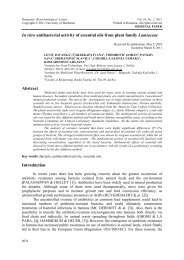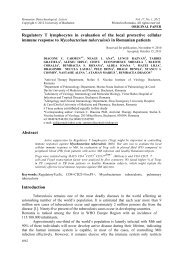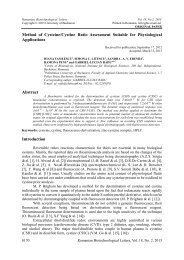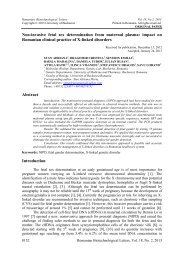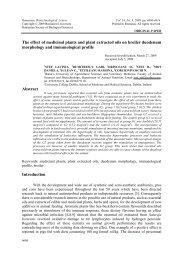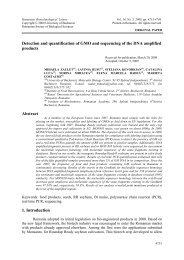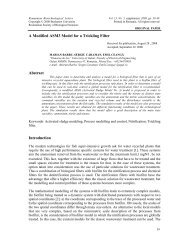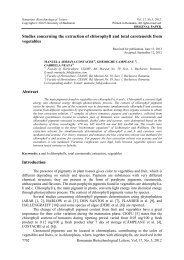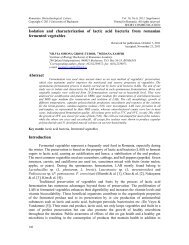Fission yeast Schizosaccharomyces pombe as a ... - Rombio.eu
Fission yeast Schizosaccharomyces pombe as a ... - Rombio.eu
Fission yeast Schizosaccharomyces pombe as a ... - Rombio.eu
Create successful ePaper yourself
Turn your PDF publications into a flip-book with our unique Google optimized e-Paper software.
Romanian Biotechnological Letters Vol. 14, No. 2, 2009, pp. 4201-4210Copyright © 2008 Bucharest UniversityPrinted in Romania. All rights reservedRomanian Society of Biological SciencesREVIEW<strong>Fission</strong> <strong>ye<strong>as</strong>t</strong> <strong>Schizosaccharomyces</strong> <strong>pombe</strong> <strong>as</strong> a producer and secretor ofheterologous proteinsAbstractReceived for publication, November 12, 2008Accepted, March 1, 2009ELENA PETRESCU-DĂNILĂ, MANUELA VOICU, RALUCA STĂNESCU,BOGDAN STOICA, MIRCEA RUSU *University of Medicine and Pharmacy „Gr.T. Popa” IaşiFaculty of MedicineDepartment of Biochemistry*Corresponding author: E-mail mgrusu@bioch_m.umfi<strong>as</strong>i.roMicroorganisms are widely used <strong>as</strong> producers of heterologous (foreign) proteins of medical orindustrial interest. Bacteria are the most efficient producers, but they are not able to perform the posttranslationalprocessing of <strong>eu</strong>caryotic proteins (folding, glycosylation, phosphorylation or removal ofpart of their initial sequence). Eucaryotic <strong>ye<strong>as</strong>t</strong>s are able to do the post-translational processing andsecrete heterologous <strong>eu</strong>caryotic proteins in their native, biologically functional form. Among <strong>ye<strong>as</strong>t</strong>s, thefission <strong>ye<strong>as</strong>t</strong> <strong>Schizosaccharomyces</strong> <strong>pombe</strong> h<strong>as</strong> the advantage of being more similar to higher <strong>eu</strong>caryotesin many respects, but its heterologus protein production is still small compared to that of other <strong>ye<strong>as</strong>t</strong>ssuch <strong>as</strong> Saccharomyces cerevisiae, Pichia p<strong>as</strong>toris or Kluyveromyces lactis. However, the good qualityof proteins obtained so far makes fission <strong>ye<strong>as</strong>t</strong> an interesting producer and efforts are being made bymany researchers to modify the gemome of S. <strong>pombe</strong> in order to obtain better producers of proteins.This review presents these efforts up to date and describes expression systems, signaling peptides, posttranslationalprocessing and secretion systems known in fission <strong>ye<strong>as</strong>t</strong>, and the possible ways to incre<strong>as</strong>etheir efficiency. The l<strong>as</strong>t paragraphs are dedicated to approaching methods and protocols of genomicmodifications.Keywords: heterologous protein, expression, traffic, secretion.IntroductionHeterologous protein production is mainly a biotechnological topic. Unicellularmicroorganisms, both procaryotic and <strong>eu</strong>caryotic, are the preferred heterologous proteinproducers for obvious re<strong>as</strong>ons: they can be cultured in big amounts, at low costs, theirmanipulation is simple and their genetic background is well known and accessible formanipulations. Some proteins can be secreted into the medium from where they can be e<strong>as</strong>ilyrecovered and purified. The proteins thus produced can be used <strong>as</strong> medicines, vaccines,laboratory or industrially useful enzymes or food components. A few recent or recentlyupdated examples (restricted to <strong>ye<strong>as</strong>t</strong>s <strong>as</strong> producers) are: production of insulin by S. cerevisiae[1], production of influenza virus proteins usable <strong>as</strong> vaccine components by theSaccharomyces <strong>ye<strong>as</strong>t</strong> [2, 3, 4], production of hepatitis C virus proteins by Pichia p<strong>as</strong>toris withthe aim of preparing a vaccine [5], production of industrially or laboratory usable enzymes byPichia p<strong>as</strong>toris [6, 7].As producers, a large and ever-incre<strong>as</strong>ing number of unicellular organisms are beingused: procaryotic (bacterial) organisms such <strong>as</strong> Escherichia coli, Bacilus (subtilis, braevis), orsimple <strong>eu</strong>caryotes such <strong>as</strong> Saccharomyces cerevisiae, Picchia p<strong>as</strong>toris, Kluyveromyces lactis,<strong>Schizosaccharomyces</strong> <strong>pombe</strong>. For a given protein each of the organisms may be more or lessappropriate. The advantage of bacterial producers is the high yield of production and the e<strong>as</strong>e4201
ELENA PETRESCU-DĂNILĂ, MANUELA VOICU, RALUCA STĂNESCU, BOGDAN STOICA,MIRCEA RUSUof genetic manipulation. They are most appropriate for the production of proteins of bacterialorigin. Gram-negative bacteria such <strong>as</strong> Escherichia have the advantage of a very well knowngenome and the existence of a large choice of well characterized mutant strains exhibitingspecial qualities, but have the inconvenient of sequestering the secreted proteins in theperipl<strong>as</strong>mic space; Gram-positive Bacillus bacteria are devoid of the outer membrane and cansecrete proteins directly into the medium [8, 9]. A major inconvenient of the bacterialproducers is that they lack the equipment needed for the <strong>eu</strong>caryotic proteins to be processedpost-translationally and to become functional and able to be secreted. Ye<strong>as</strong>ts possess thatequipment and therefore they are preferred for the production of heterologous <strong>eu</strong>caryoticproteins.From this point of view the fission <strong>ye<strong>as</strong>t</strong> <strong>Schizosaccharomyces</strong> <strong>pombe</strong> appears to be agood choice for mammalian heterologous protein production. S. <strong>pombe</strong> h<strong>as</strong> more similargenomic features to higher <strong>eu</strong>caryotes than other <strong>ye<strong>as</strong>t</strong>s. Some human genes (like cdk1) wereable to replace homologous genes that were deficient in fission <strong>ye<strong>as</strong>t</strong>, which proves that theencoded proteins are functional in S. <strong>pombe</strong> [10]. Some transcription promoters from humancells work <strong>as</strong> promoters in the fission <strong>ye<strong>as</strong>t</strong> <strong>as</strong> well [10]. The signal for retention of proteins inthe endopl<strong>as</strong>mic reticulum (ER) - the carboxy-terminal KDEL sequence - is identical infission <strong>ye<strong>as</strong>t</strong> and in mammals, but different from that of other <strong>ye<strong>as</strong>t</strong>s [11]. The Golgi system isstructurally well represented in S. <strong>pombe</strong> but less visible in other <strong>ye<strong>as</strong>t</strong>s such <strong>as</strong>Saccharomyces cerevisiae and Pichia p<strong>as</strong>toris [12, 13]. However, the fission <strong>ye<strong>as</strong>t</strong> h<strong>as</strong> beenless used for human protein production than other <strong>ye<strong>as</strong>t</strong>s so far. The re<strong>as</strong>on is that the bestsecretion of such proteins w<strong>as</strong> evaluated at 20 mg/l/24 hours [12], in S. <strong>pombe</strong> compared to afew grams/l/24 hours in Bacillus bacteria. Certainly, the quality of secreted proteins may beimportant, still a higher secretion is desirable and this is the target of nowadays ongoingresearch [13].The steps of protein production and secretionIn order to obtain a high protein production by a microorganism, the followingconditions are necessary: 1) High expression of the gene encoding that protein in the producerorganism; 2) Efficient translation of the genetic information; 3) Efficient folding, posttranslationalprocessing, intracellular traffic of the protein and its secretion; 4) Avoiding theproteins’ destruction both in and out of the cells by lytic enzymes. We shall present theessential of these data, stressing on fission <strong>ye<strong>as</strong>t</strong>.1. Gene expression is usually the rate limiting step of protein synthesis. It is me<strong>as</strong>ured<strong>as</strong> the amount of specific mRNA extracted from cells. The expression of a heterologous genecan be incre<strong>as</strong>ed by incre<strong>as</strong>ing the number of copies of the respective gene in the cell. Usuallya foreign gene is introduced into the producer cell through a pl<strong>as</strong>mid which can multiplyindependently of the chromosomal DNA, this resulting in a number of copies per cell.Pl<strong>as</strong>mids are not evenly distributed between the sister cells in mitosis so that, after severalrounds of cell division, some cells lose pl<strong>as</strong>mids altogether. This genetic instability is aninconvenient that can be circumvented by maintaining the cells in a selective medium thatonly allows growth of the cells possessing the pl<strong>as</strong>mid (which also h<strong>as</strong> to contain a selectionmarker gene).Another method to obtain high expression of a heterologous gene is to place it under thecontrol of an active promoter, i.e. a DNA sequence upstream of the gene that ensures thefunctioning of the transcription complex. The promoter is usually homologous (belongs to theproducer organism). In the fission <strong>ye<strong>as</strong>t</strong> <strong>Schizosaccharomyces</strong> <strong>pombe</strong> the thiamine-repressiblepromoter of the nmt1 gene is largely used (see also Table 1). A gene under its control can be4202Rom. Biotechnol. Lett., Vol. 14, No. 2, 4201-4210 (2009)
<strong>Fission</strong> <strong>ye<strong>as</strong>t</strong> <strong>Schizosaccharomyces</strong> <strong>pombe</strong> <strong>as</strong> a producer and secretor of heterologous proteinsexpressed a few hundred folds when thiamine is absent in the growth medium than when it ispresent [14]. Another homologous expression system is that of the pho1 gene. Its expressionis low when adenine in the medium is abundant, but incre<strong>as</strong>es about 40 fold when adenine islimiting [15]. We have shown recently that expression of pho1 is under the negative control ofa system involving a 14-3-3 protein encoded by rad24 gene. Deletion of rad24 enhances pho1expression about 100 fold [16]. A heterologous promoter being used is that of the humancytomegalic virus [10].A heterologous gene can be inserted into the chromosome downstream of the activegene promoter or, alternatively, both the promoter and the gene may be included in a pl<strong>as</strong>midwhich is transformed into the producer organism, thus combining the generation of multiplecopies of the gene with its incre<strong>as</strong>ed transcription.Table 1. Expression systems designed or used for heterologuos proteins production in <strong>Schizosaccharomyces</strong><strong>pombe</strong>Category(pl<strong>as</strong>mid orgenomicinsertion)Promoter Number ofheterologousgenecopiesObservations and referencespRepnmt1 (homologous,thiamine-repressible)~ 500 Constructed accordingly to [14]. Used forGFP (green fluorescent protein) overexpressionby [12, 17]pTL2MI hCMV (heterologous, 200 Constructed and used by [10] for thepSL2MIconstitutive)hCMV (heterologous, 200expression and secretion of humanhypophyseal growth hormone .constitutive)Insert nmt1, nmt41, nmt81(homologous, thiaminerepressible)1 Proposed by [20] for controlled expression ofseveral genes.Insert pho1 (homologous,adenine-repressible)1 Proposed by [15, 16] <strong>as</strong> a possible adeninecontrolledexpression systemInsert hCMV 4 Constructed and used by [18, 19] for theproduction and secretion of humanhypophyseal growth hormone.Expression system’s choice is an important step for the production and secretion ofheterologous proteins. The most efficient expression system is usually chosen. However thesecretion might not be <strong>as</strong> high <strong>as</strong> the expression and this fact may have some consequences. Ifthe heterologuous protein is toxic for the producing cell, it is more convenient to choose anexpression system repressible by one of the metabolites in the medium (thiamine or adeninefor fission <strong>ye<strong>as</strong>t</strong>, see also Table 1). Such a system will allow the expression only when thisfactor is consumed and the cell number is big enough to produce a high protein quantitybefore the cell death. Another consequence of overexpression is triggering of an inhibitorycontrol system due to a high number of unfolded or incorrectly folded polypeptide chains, <strong>as</strong>it will be shown further in this review. In this c<strong>as</strong>e a lower expression system may be used.2. When the expression of the heterologous protein encoding gene is very high, thesubsequent steps may be rate-limiting for protein secretion. To our knowledge there is no datain the scientific literature to show that translation can be rate-limiting in the c<strong>as</strong>e ofheterologous protein production. However, post-translational processing and the trafficmechanisms of protein exporting can.3. Post-translational processing and protein secretion. After translation, a proteindestined to be exported outside the cell may follow one of the secretion pathways existent inboth procaryotes and <strong>eu</strong>caryotes. Two such pathways are known in fission <strong>ye<strong>as</strong>t</strong>, followed byRom. Biotechnol. Lett., Vol. 14, No. 2, 4201-4210 (2009) 4203
ELENA PETRESCU-DĂNILĂ, MANUELA VOICU, RALUCA STĂNESCU, BOGDAN STOICA,MIRCEA RUSUits two peptide pheromones: a) pheromone P pathway or the cl<strong>as</strong>sic secretion pathway,involving the p<strong>as</strong>sage through the ER (endopl<strong>as</strong>mic reticulum) and the Golgi system; b)pheromone M pathway, independent of ER and Golgi but depending on the ABC transporter,a protein system in the pl<strong>as</strong>ma membrane.a) Endopl<strong>as</strong>mic reticulum depending pathway. The polypeptide chain synthesized inthe ribosomes attached to the ER membrane (where it can be folded and subjected to the firstpost-translational processing) h<strong>as</strong> to begin at the N terminal with the so called leader peptide,a sequence of about 20 amino acids. The leader peptide serves <strong>as</strong> a signal for driving thenewly synthesized polypeptide (pre-pro-protein) to the ER, a signal that is recognized by theSRP (Signal Recognition Particle) protein complex. In the heterologous protein technologythe leader peptide h<strong>as</strong> to belong to one of the homologous proteins, i.e. the heterologousexpression construct h<strong>as</strong> to consist of the tandem: active promoter (homologous orheterologous) - leader peptide encoding sequence (homologous) - gene encoding theheterologous protein. Obviously, this tandem is a recombinant construct. For the productionof heterologous proteins by <strong>Schizosaccharomyces</strong> <strong>pombe</strong> a few leader peptides have beenused: the P3 leader peptide (belonging to the P pheromone precursor, encoded by map2 gene)[19], the pho1 leader peptide [17] and the carboxypeptid<strong>as</strong>e Y leader peptide (encoded bycpy1gene) [12] (see also Table 2).NameP3Cpy 1Pho 1Mfm 1Table 2. Signal sequences for secretion pathways used by heterologous proteins infission <strong>ye<strong>as</strong>t</strong>Access no. inAmino acid sequenceObservation and referencesNCBI datab<strong>as</strong>emap2 NM MKITAVIALLFSLAAASPIPVAD Used by [18] for hypophyseal001023030growth hormone secretion and by[12] for GFP secretion.cpy1 NM MLMKQTFLYFLLTCVVSAQFNGY Used by [12] for GFP and TNF001019854pho1 NM001023870mfm1 NM001020207VPPEMFLQNLFLGFLAVVCANAQFAEMDSMANSVSSSSVVNAGNKPAETLNKTVKN-YTPKVPYMC-VIA(tumor necrosis factor) secretion.Used by [17] for GFP and HPV(human papilloma virus)secretion.Used by [37] for GFP secretion.The leader sequences of different homologous polypeptide chains are not identical, butthey keep a common general pattern with respect to the constitutive amino acid side chains: 1-5 amino acids with cationic groups (arginine-R, lysine-K, histidine-H) and a core of 6-15hydrophobic amino acids followed by 3-7 polar amino acids that serve <strong>as</strong> signal for thepeptid<strong>as</strong>es that will remove the leader peptide in the ER [21]. The leader sequences are notequally efficient <strong>as</strong> secretion signals for all heterologous proteins. In fission <strong>ye<strong>as</strong>t</strong> forexample, the Cpy1 sequence attached to GFP (green fluorescent protein from Aequoreavictoria jelly fish) produces a secretion that is several fold more efficient than that of the P3sequence [12] (see also Table 2). The causes of this phenomenon remain misunderstood,especially since the leader sequence is removed from the secreted protein while this is stillinside the ER. Thus in an attempt of constructing a gene encoding a heterologous proteindestined to be secreted, several leader sequences have to be tested in order to choose the moreconvenient one.The leader peptide is removed in the ER <strong>as</strong> one of the first post-translational processingevents. At the same time, protein folding occurs. This is facilitated by some proteincomplexes. Two main complexes are present in the ER: i) Lectin complex consisting of4204Rom. Biotechnol. Lett., Vol. 14, No. 2, 4201-4210 (2009)
<strong>Fission</strong> <strong>ye<strong>as</strong>t</strong> <strong>Schizosaccharomyces</strong> <strong>pombe</strong> <strong>as</strong> a producer and secretor of heterologous proteinscalnexin (an ER membrane integral protein), calreticulin (a soluble protein), a thioloxidoreduct<strong>as</strong>e and a few other proteins. This complex recognizes the newly formed substratepolypeptides on their glycosyl residues after they have been N glycosylated [22, 23]; ii)Chaperone complex consisting of several proteins of the Hsp70 and Hsp40 cl<strong>as</strong>ses.Chaperones contribute to correct folding of the newly synthesized polypeptides by bindingthem on some of the chaperone’s hydrophobic residues (an ATP-dependent process)precluding in this way hydrophobic aggregation of the newly synthesized proteins amongthemselves and facilitating their correct folding. The absence of these proteins leads to adecre<strong>as</strong>e in homologous and heterologous protein production and secretion.<strong>Fission</strong> <strong>ye<strong>as</strong>t</strong> h<strong>as</strong> genes encoding both calnexin [11, 23] and BiP, an Hsp70 cl<strong>as</strong>shomologue [24]. The roles of calnexin and of BiP protein are different: calnexin retains BiPand other proteins which are “resident” in the ER lumen due to the recognition andattachement to a carboxy-terminal tetrapeptide common to all of these proteins [11]. In S.cerevisiae the BiP chaperone stabilizes a protein located in the membrane of the ER tubules(Ire1p) by attaching to it. The existence of a large number of unfolded polypeptide chainscompetes with Ire1p for BiP, so that BiP dissociates from Ire1p and the latter dimerises andtriggers an UPR (unfolded protein response) which consists of reshaping an RNA species.This RNA regulates the transcription of at le<strong>as</strong>t 300 genes, some of their products being ableto modulate the expression of proteins such <strong>as</strong> BiP and PDI (protein disulphide isomer<strong>as</strong>e),but also to decre<strong>as</strong>e the expression of proteins that have triggered the UPR [25]. Calnexin andBiP probably also have common functions with respect to <strong>as</strong>sisting the polypeptide chainsfolding, because the overexpression of one of them can compensate the lack of the other onein this process and in maintaining the cells viability [26]. These data are established forSaccharomyces cerevisiae and are also probably valid for <strong>Schizosaccharomyces</strong> <strong>pombe</strong>. Table3 presents the proteins participating in the ER depending secretion process and the genesencoding them in S. <strong>pombe</strong> <strong>as</strong> well <strong>as</strong> their orthologues (homologues with the same function)in other species such <strong>as</strong> Saccharomyces cerevisiae and Homo sapiens.BiPCalnexinTable 3. Proteins involved in the secretion of homologous or heterologous proteins in<strong>Schizosaccharomyces</strong> <strong>pombe</strong>Name Function Codinggene inS. <strong>pombe</strong>Orthologues inother speciesChaperone from the ER. It „<strong>as</strong>sists” thePDI – Proteindisulphideisomer<strong>as</strong>eERO – Endopl<strong>as</strong>micreticulumfolding of polypeptide chains in the ER.Lectin from the ER. It retains the proteinshaving a „residence” signal in the ERtubules.Proteins containing disulphide bonds. They„<strong>as</strong>sist” S-S bonds formation in the processof protein folding in the ER lumen.Catalyzes the generation of S-S bonds inPDI enzymes.ReferencesSp-BiP Hs-BiP, Sc-KAR2 [24]Sp-cnx1 Sc-CNE1, Hs-CLNX [11,23]Sp-pdi1 Sc-PDI1 [27]Sp-ero1-1 Sc-ERO1-1 [8]oxid<strong>as</strong>esYpt 1 GTP<strong>as</strong>e involved in vesicular traffic. Sp-ypt1 Hs-rab1 [31]Ypt2 GTP<strong>as</strong>e involved in vesicular traffic. Sp-ypt2 Sc-SEC4, Hs-rab8 [32]Ypt3 GTP<strong>as</strong>e involved in vesicular traffic. Sp-ypt3 Sc-YPT3, Hs-rab11 [33]Ypt5 GTP<strong>as</strong>e involved in vesicular traffic. Sp-ypt5 Hs-rab5 [34]Mam1 Component of the ABC export system. Sp-mam1 Sc-STE6 [37]Rom. Biotechnol. Lett., Vol. 14, No. 2, 4201-4210 (2009) 4205
ELENA PETRESCU-DĂNILĂ, MANUELA VOICU, RALUCA STĂNESCU, BOGDAN STOICA,MIRCEA RUSUOther proteins important for secretion and resident in the ER are those upon whichdisulphide bond formation depends. Protein disulphide isomer<strong>as</strong>e (PDI) is one of them. Thisenzyme, containing itself disulphide bonds, is an isomer<strong>as</strong>e (it catalyses the exchange of somedisulphide bonds with others in the same molecule) and an oxidoreduct<strong>as</strong>e (it catalyses theformation of disulphide bonds by oxidation or their cleavage by reduction). Otheroxidoreduct<strong>as</strong>es having disulphide bonds <strong>as</strong> substrates are ERO (oxid<strong>as</strong>es from the ER).These enzymes have PDI <strong>as</strong> a substrate and are a reservoir of oxidized disulphide bonds.Proteins of both PDI and ERO type are encoded in the genome of fission <strong>ye<strong>as</strong>t</strong> and of all thespecies that have been studied in this regard (Table 3 and included references). A series ofother proteins in the chaperone and oxidoreduct<strong>as</strong>e category have been found in budding<strong>ye<strong>as</strong>t</strong>, but not yet in fission <strong>ye<strong>as</strong>t</strong>. As far <strong>as</strong> the heterologous protein production is concerned,the folding step could (when rate limiting) be improved by chaperone overexpression inPichia p<strong>as</strong>toris [29] or overexpression of proteins contributing to disulphide bonds formationin Kluyveromyces lactis [30].The intracellular protein traffic consists of an orderly p<strong>as</strong>sing of a protein throughvarious compartments of the Golgi system where they undergo specific post-translationalprocessing, especially glycosylations. Finally, a protein that does not have a signal sequenceto direct it to other destinations (nucl<strong>eu</strong>s, mitochondria, pl<strong>as</strong>ma membrane) is exportedthrough an exocytosis process. Both traffic and exocytosis involve forming of lipid vesicles inwhich proteins are included. A series of small GTP-<strong>as</strong>sociated proteins, named Rab inmammals and Ypt in <strong>ye<strong>as</strong>t</strong>s, participate in this process (table 3 and included references). Atle<strong>as</strong>t one of these proteins, Ypt3, h<strong>as</strong> proved to be important for the export of a heterologousprotein (GFP with the Pho1 leader peptide) in S. <strong>pombe</strong> [33]. Inositol phosphatides also havea major importance for trafficking [35]. We have reported data that suggest the requirement ofinositol for intracellular traffic of the P pheromone and the M and P pheromone receptors in<strong>Schizosaccharomyces</strong> <strong>pombe</strong> [36].b) The ABC export pathway, independent of ER and Golgi system. This pathway existsin both procaryotes and <strong>eu</strong>caryotes. The ABC transporter is located in the pl<strong>as</strong>ma membraneand facilitates protein translocation by using ATP. A component of the ABC system in S.<strong>pombe</strong> is the protein encoded by mam1 gene [37]. Besides the membrane transporter, theother components of the system are unknown. The secretion might depend on a vesicular(vacuolar) system which is different from the Golgi apparatus. As this system represents thenatural pathway of secretion for the M pheromone, it h<strong>as</strong> been used <strong>as</strong> a signal for thesecretion of a reporter recombinant protein (GFP) by Kjaerulff et al. [37]. They proved thatthe greatest secretion efficiency is obtained by placing the heterologous protein in-betweenthe prosequence of the M pheromone precursor and the part coding for the pheromoneaminoacid sequence (in Table 2 the insertion place of the heterologous sequence is in-betweenN-Y written in bold face). The „pro” sequence of the precursor (from the NH 2 terminal toglutamine-N 30, see Table 2) is essential for secretion, <strong>as</strong> well <strong>as</strong> the carboxy-terminalaminoacid triad. Even though apparently more simple, the export through this pathway h<strong>as</strong>n’tproved to be more efficient than the one through the complex pathway involving the ER andthe Golgi system [37].4. The rate and quality of protein secretion is often dependent on both intra andextracellular (secreted) prote<strong>as</strong>es. A particular c<strong>as</strong>e of intracellular prote<strong>as</strong>es is that of proproteinconverting prote<strong>as</strong>es which are involved in post-translational processing byproteolytic cleavage. Kexins represent a subcl<strong>as</strong>s of these prote<strong>as</strong>es and have been describedin many species. The fission <strong>ye<strong>as</strong>t</strong> S. <strong>pombe</strong> h<strong>as</strong> a known kexin, encoded by krp1 gene that isinvolved in pro-pheromones processing. There have also been described some other genescoding for putative pro-protein converting prote<strong>as</strong>es [38]. The problem of pro-protein4206Rom. Biotechnol. Lett., Vol. 14, No. 2, 4201-4210 (2009)
<strong>Fission</strong> <strong>ye<strong>as</strong>t</strong> <strong>Schizosaccharomyces</strong> <strong>pombe</strong> <strong>as</strong> a producer and secretor of heterologous proteinsprocessing is interesting in the technology of heterologous protein production when theseproteins must undergo such a processing (proinsulin, for example). Other prote<strong>as</strong>es,intracellular (cytopl<strong>as</strong>matic or lysosomal) or extracellular (secreted) are important <strong>as</strong> factorsto be avoided in heterologous protein production. It h<strong>as</strong> been reported that the deletion of anyone of 13 genes encoding prote<strong>as</strong>es in <strong>Schizosaccharomyces</strong> <strong>pombe</strong> improved heterologoushuman growth hormone (hGH) production [19]. The deletion of ppp80 gene, encoding acystein prote<strong>as</strong>e, leads to a spectacular incre<strong>as</strong>e of hGH secretion. Combining this deletionwith the deletion of other 6 genes encoding different prote<strong>as</strong>es incre<strong>as</strong>es the secretion 2 moretimes [18, 19].5. Other factors leading to an incre<strong>as</strong>ed efficiency of <strong>Schizosaccharomyces</strong> <strong>pombe</strong><strong>ye<strong>as</strong>t</strong> <strong>as</strong> a heterologous protein producer. Recently, Y. Giga-Hama’s group proposed <strong>as</strong>eries of genetic modifications of fission <strong>ye<strong>as</strong>t</strong> which lead to a better efficiency ofheterologous proteins production and secretion. The authors started from the hypothesis thatsome nonessential genes can be deleted without producing growth limitations, but onlyauxotrophies (the requirement for nutritional factors in the culture medium). These deletionswould lead, on the other hand, to energy sparing and to greater productions of the proteins ofinterest. The deletion of a chromosomal region of 500 kb coupled with the deletion of someimportant genes involved in the carbohydrate and amino acid metabolism, and also of someprote<strong>as</strong>e encoding genes leads to a remarkable incre<strong>as</strong>e in human growth hormoneheterologous production [13].APPROACHING METHODS AND USEFUL PROTOCOLSIn order to introduce the genes encoding foreign proteins, sequence signals, promoters,etc. into the genome of the producing cells, there can be used episomal modifiers of thegenome or chromosomal insertions.1. Episomal factors. The recombinant pl<strong>as</strong>mids must contain an autonomous replicationcenter (the most utilised is the ars1 sequence), a selectable marker (a gene that confersprototrophy to an auxotrophic strain or a gene conferring resistance to a particular antibiotic,etc.), and a polylinker sequence (recognized by several restriction enzymes) where the genesencoding heterologous proteins can be inserted. An expression promoter must be added at adistance of 25-39 nucleotides from the insertion point of the heterologous gene. One of thenmt variants (thiamine-repressible) is the most common promoter, but other promoters can b<strong>eu</strong>sed <strong>as</strong> well (see Table 1). Such a pl<strong>as</strong>mid is pRep, initially designed by Maundrell [14] andsubsequently modified variants. The pl<strong>as</strong>mids can be constructed or obtained from theirauthors. The gene coding for the heterologous protein can be PCR-amplified from the genomeof the original organism using total DNA or cDNA (copy of messenger RNA) <strong>as</strong> a template.Amplification on cDNA is more advantageous <strong>as</strong> the gene contains only the coding part,without introns. The DNA fragment containing the gene of interest must be flanked byrestriction sites (designed by PCR primers sequences) in order to enable the subsequentinsertion in the polylinker of the pl<strong>as</strong>mid vector, which h<strong>as</strong> been linearized with the samerestriction enzyme. After subsequent ligation, the gene encoding the heterologous protein isplaced under the control of the chosen expression promoter. The transforming of pl<strong>as</strong>midsinto the cells can be carried out according to several protocols; one of them with goodtransformation efficiency is described in [20].2. Linear modules for chromosomal insertion. In principle, such a module h<strong>as</strong> tocontain the gene of interest under the control of an expression promoter <strong>as</strong> well <strong>as</strong> a selectablemarker gene, flanked by two fragments that are homologous to two chromosomal sequencesflanking the point where the module h<strong>as</strong> to be inserted (target). These homologous fragmentsRom. Biotechnol. Lett., Vol. 14, No. 2, 4201-4210 (2009) 4207
ELENA PETRESCU-DĂNILĂ, MANUELA VOICU, RALUCA STĂNESCU, BOGDAN STOICA,MIRCEA RUSUensure the insertion at the target by a homologous recombination process consisting of twocrossings-over. The linear modules can be made by PCR amplification of constructscontaining the tandem: active promoter (homologous or heterologous) - leader peptideencoding sequence (homologous) - gene encoding the heterologous protein - selection marker,included in a pl<strong>as</strong>mid. The primers of approximately 80 nucleotides are each composed of along (approx. 60 nucleotides) sequence homologous to the target and an additional shortersequence (about 20 nucleotides) homologous to the ends of the tandem. A collection of suchmodules is described in [20]. A better method (<strong>as</strong> providing longer homologous ends) seemsto be the construction of linear inserts by fusing the tandem’s amplicon (the insert) withamplicons of two sequences 500 bp each, homologous to the genome target sequences(flanks). The two flanking amplicons can be made by PCR amplification using genomic DNA<strong>as</strong> a template and primers that are identical partially to the flanks and partially to the insert.The insert and the flanks can then be fused together in a single construct by fusion PCR, dueto their partial overlapping [39,40].Once the strain expressing the heterologous gene h<strong>as</strong> been constructed, it is grown inthe most favorable conditions for producing the protein of interest. The secretion of theprotein may be quantified in the growth medium by immunochemical methods (westernblotting).References1. T. KJELDSEN, S. LUDVIGSEN, I. DIERS, P. BALSCHMITD, A.R. SORENSEN, N.C. KAARSHOLM.Engeneering enhanced protein secretory expression in <strong>ye<strong>as</strong>t</strong> with application to insulin. J. Biol. Chem., 277,18245-18248 (2002).2. X. SAELENS, P. VANLANDSCHOOT, W. MARTINET, M. MARAS, S. NEIRYNCK, R. COTRERAS,W. FIERS, W.M. JOU. Protection of mice against a lethal influenza virus challenge after immunization with<strong>ye<strong>as</strong>t</strong>-derived secreted influenza virus hemagglutinin. Eur. J. Biochem., 260(1), 166-175 (1999).3. A. WADLE, G. HELD, F. NEUMANN, S. KLEBER, B. WUELLNER, A.M. ASEMISSEN, B.KUBUSCHOK, C. SCHEIBENBOGEN, T. BREINING, A. MEYERHANS, C. RENNER. Crosspresentationof HLA cl<strong>as</strong>s I epitopes from influenza matrix protein produced in Saccharomyces cerevisiae.Vaccine, 11(24), 6272-6281 (2006).4. C.Y. WANG, Y.L. LUO, Y.T. CHEN, S.K. LI, C.H. LIN, Y.C. HSIEH, H.J. LIU. The cleavage of thehemagglutinin protein of H5N2 avian influenza virus în <strong>ye<strong>as</strong>t</strong>. J. Virol. Meth., 146, 293-297 (2007).5. G. MARTINEZ-DONATO, N. ACOSTA-RIVERO, J. MORALES-GRILLO, A. MUSACCHIO, A. VINA,C. ALVAREZ, N. FIGUEROA, I. GUERRA, J. GARCIA, L. VARAS, V. MUZIO, S. DUENAS-CARRERA. Expression and processing of hepatitis C virus structural proteins in Pichia p<strong>as</strong>toris <strong>ye<strong>as</strong>t</strong>.Biochem. Biophys. Res. Commun., 342, 625-631 (2006).6. N. JUGE, G. WILLIAMSON, A. PUIGSERVER, N.J. CUMMINGS, I.F. CONNERTON, C.B. FAULDS.High-level production of recombinant Aspergillus niger cinnamoyl ester<strong>as</strong>e (FAEA) in the methylotrophic<strong>ye<strong>as</strong>t</strong> Pichia p<strong>as</strong>toris. FEMS Ye<strong>as</strong>t Res., 1, 127-132 (2001).7. J.G. BERRIN, W.R. MCLAUCHLAN, P. NEEDS, G. WILLIAMSON, A. PUIGSERVER, P.A. KROON,N. JUGE. Functional expression of human liver cytosolic beta glucosid<strong>as</strong>e în Pichia p<strong>as</strong>toris. Insights intoits role în the metabolism of dietary glucosides. Eur. J. Biochem., 269, 249-258 (2002).8. L. WESTERS, H. WESTERS, W.J. QUAX. Bacillus subtilis <strong>as</strong> cell factory for pharmac<strong>eu</strong>tical proteins: abiotechnological approach to optimize the host organism. Biochim. Biophys. Acta, 11, 299-310 (2004).9. G. GEORGIU, L. SEGATORI. Preparative expression of secreted proteins in bacteria: status report andfuture prospects. Curr. Opin. Biotechnol., 16, 538-545 (2005).10. Y. GIGA-HAMA, H. KUMAGAI. Expression system for foreign genes using the fission <strong>ye<strong>as</strong>t</strong>Schiz<strong>as</strong>accharomyces <strong>pombe</strong>. Biotechnol. Appl. Biochem., 30, 235-244 (1999).11. F. PARLATI, D. DIGNARD, J.J. BERGERON, D.Z. THOMAS. The calnexin homologue cnx1 in<strong>Schizosaccharomyces</strong> <strong>pombe</strong> is an essential gene which can be complemented by its soluble ER domain.EMBO J., 14, 3064-3072 (1995).4208Rom. Biotechnol. Lett., Vol. 14, No. 2, 4201-4210 (2009)
<strong>Fission</strong> <strong>ye<strong>as</strong>t</strong> <strong>Schizosaccharomyces</strong> <strong>pombe</strong> <strong>as</strong> a producer and secretor of heterologous proteins12. S. KJAERULFF, M.R. JENSEN. Comparison of different signal peptides for secretion of heterologousproteins in fission <strong>ye<strong>as</strong>t</strong>. Biochem. Biophys. Res. Commun., 336, 974-982 (2005).13. Y. GIGA-HAMA, H. TOHDA, K. TAKEGAWA, H. KUMAGAI. <strong>Schizosaccharomyces</strong> <strong>pombe</strong> minimumgenome factory. Biotechnol. Appl. Biochem., 46, 147-155 (2007).14. K. MAUNDRELL. Thiamine repressible expression vectors pRep and pRip for fission <strong>ye<strong>as</strong>t</strong>. Gene, 123,127-130 (1993).15. M.E. SCHWEINGRUBER, E. EDENHARTER, A. ZURLINDEN, K.M. STOCKMEYER. Regulation ofpho1-encoded acid phosphat<strong>as</strong>e of <strong>Schizosaccharomyces</strong> <strong>pombe</strong> by adenine and phosphate. Curr. Genet.,22, 289-292 (1992).16. P.M. VOICU, E. PETRESCU-DĂNILĂ, M. POIŢELEA, A. WATSON, M. RUSU. In<strong>Schizosaccharomyces</strong> <strong>pombe</strong> the 14-3-3 protein Rad24p is involved in negative control of pho1 geneexpression. Ye<strong>as</strong>t, 24(2), 121-127 (2007).17. J. BRASPENNING, W. MESCHEDE, A. MARCHINI, M. MULLER, L. GISSMAN, M. TOMMASINO.Secretion of heterologous proteins from <strong>Schizosaccharomyces</strong> <strong>pombe</strong> using the homologous leadersequence of pho1 acid phosphat<strong>as</strong>e. Biochem. Biophys. Res. Commun., 245, 166-171 (1998).18. A. IRIDIS, K.W. BI, H. TOHDA, H. KUMAGAI, Y. GIGA-HAMA. Construction of a prote<strong>as</strong>e-deficientstrain set for the fission <strong>ye<strong>as</strong>t</strong> <strong>Schizosaccharomyces</strong> <strong>pombe</strong>, useful for effective production of prote<strong>as</strong>esensitiveheterologous proteins. Ye<strong>as</strong>t, 23, 83-99 (2006).19. A. IRIDIS, H. TOHDA, K.W BI, A. ISOAI, H. KUMAGAI, Y, GIGA-HAMA. Enhanced productivity ofprote<strong>as</strong>e-sensitive heterologous proteins by disruption of multiple prote<strong>as</strong>e genes în the fission <strong>ye<strong>as</strong>t</strong><strong>Schizosaccharomyces</strong> <strong>pombe</strong>. Appl. Mircrobiol. Biotechnol., 73, 404-420 (2006).20. J. BAHLER, J-Q WU, M.S. LONGTINE, N.G. SHAH, A MCKENZIE III, A. STEEVER, A. WACH, P.PHILIPSEN, J. PRINGLE. Heterologous modules for efficient and versatile PCR-b<strong>as</strong>ed gene targeting in<strong>Schizosaccharomyces</strong> <strong>pombe</strong>. Ye<strong>as</strong>t, 14, 943-951 (1998).21. G. VON HEINE. Signal sequences. The limits of variation. J. Mol. Biol., 184, 99-105 (1985).22. V.S. STRONGE, Y. SAITO, Y. IHARA, D.B. WILLIAMS. Relationship between calnexin and BiP insuppressing aggregation and promoting refolding of protein and glycoprotein substrates. J. Biol. Chem.,276, 39779-39787 (2001).23. A. MARECHAL, P.L. TANGUAY, M. CALLEJO, R. GUERRIN, G. BOILEAU, L.A. ROKEACH. Cellviability and secretion of active proteins in <strong>Schizosaccharomyces</strong> <strong>pombe</strong> do not require the chaperonefunction of calnexin. Biochem. J., 380, 441-448 (2004).24. A.L. PIDOUX, J. ARMSTRONG. Analysis of the BiP gene and identification of an ER retention signal in<strong>Schizosaccharomyces</strong> <strong>pombe</strong>. EMBO J., 11, 1583-1591 (1992).25. P. XU, D. RADEN, F.J. DOYLE III, A.S. ROBINSON. Analysis of unfolded protein response duringsingle-chain antibody expression în Saccharomyces cerevisiae reveals different roles for BiP and PDI infolding. Metab. Eng., 7, 269-279 (2005).26. H. ZHANG, J. HE, Y. JI, A. KATO, Y. SONG. The effect of calnexin deletion on the expression level ofPDI in Saccharomyces cerevisiae under heat stress conditions. Cell. Mol. Biol. Lett., 13, 38-48 (2008).27. S.J. KIM, Y.S. CHOI, H.G. KIM, E.H. PARK, C.J. LIM. Cloning, characterization and regulation of aprotein disulfide isomer<strong>as</strong>e from the fission <strong>ye<strong>as</strong>t</strong> <strong>Schizosaccharomyces</strong> <strong>pombe</strong>. Mol. Biol. Rep., 33, 187-196(2006).28. K. KETTNER, A. BLOMBERG, G. ROEDEL. <strong>Schizosaccharomyces</strong> <strong>pombe</strong> ER oxidoreductin-likeproteins SpEro1a and SpEro1b. Ye<strong>as</strong>t, 21, 1035-1044 (2004).29. W. ZHANG, H.L. ZHAO, C. XUE, X.H. XIONG, X.Q. YAO, X.Y. LI, H.P. CHEN, Z.M. LIU. Enhancedsecretion of heterologous proteins in Pichia p<strong>as</strong>toris following overexpression of Saccharomyces cerevisiaechaperone proteins. Biotechnol. Prog., 22, 1090-1095 (2006).30. T. LODI, B. NEGLIA, C. DONNINI. Secretion of human serum albumin by Kluyveromyces lactisoverexpressing K1PDI1 and K1ERO1. Appl. Environ. Microbiol., 71, 4359-4363 (2005).31. S. MIYAKE, M. YAMAMOTO. Identification of r<strong>as</strong>-related ypt family genes in S. <strong>pombe</strong>. EMBO J., 9,1417-1422 (1990).32. M.W. CRAIGHEAD, S. BOWDEN, R. WATSON, J.ARMSTRONG. Function of the ypt2 gene in theexocytic pathway of <strong>Schizosaccharomyces</strong> <strong>pombe</strong>. Mol. Biol. Cell, 4(6), 583-592 (1993).33. T. INABA, Y. NAGANO, T. NAGASAKI, Y. SASAKI. Distinct localization of two closely relatedYpt3/Rab11 proteins on the trafficking pathway in higher plants. J. Biol. Chem., 277, 9183-9188 (2002).34. J. ARMSTRONG, M.W. CRAIGHEAD, R. WATSON, S. PONNAMBALAM, S. BOWDEN.<strong>Schizosaccharomyces</strong> <strong>pombe</strong> ypt5: a homologue of the rab5 endosome fusion regulator. Mol. Biol. Cell, 4,583-592 (1993).Rom. Biotechnol. Lett., Vol. 14, No. 2, 4201-4210 (2009) 4209
ELENA PETRESCU-DĂNILĂ, MANUELA VOICU, RALUCA STĂNESCU, BOGDAN STOICA,MIRCEA RUSU35. P. DE CAMILI, S.D. EMR, P.S. MCPHERSON, P. NOVICK. Phosphoinositides <strong>as</strong> regulators inmembrane traffic. Science, 271, 1533-1538 (1996).36. P.M. VOICU, M. POIŢELEA, M.E. SCHWEINGRUBER, M. RUSU. Inositol is specifically involved in thesexual program of the fission <strong>ye<strong>as</strong>t</strong> <strong>Schizosaccharomyces</strong> <strong>pombe</strong>. Arch. Microbiol., 177, 251-258 (2002).37. S. KJAERULFF, S. MULLER, M.R. JENSEN. Alternative protein secretion: The mam1 ABC transportersupports secretion of M-factor linked GFP in fission <strong>ye<strong>as</strong>t</strong>. Biochem. Biophys. Res. Commun., 339, 1853-1859 (2005).38. G. LADDS, J. DAVEY. Identification of prote<strong>as</strong>es with shared functions to the protein processing prote<strong>as</strong>eKrp1 in the fission <strong>ye<strong>as</strong>t</strong> <strong>Schizosaccharomyces</strong> <strong>pombe</strong>. Mol. Microbiol., 38, 839-853 (2000).39. P.J.H. WERLER, E. HARTSUIKER, A.M. CARR. A simple cre-lox method for chromosomal N-terminaltagging of essential and non-essential <strong>Schizosaccharomyces</strong> <strong>pombe</strong> genes. Gene, 304, 133-141 (2003).40. E. PETRESCU-DĂNILĂ, P.M. VOICU, M. POIŢELEA, R. STĂNESCU, B. STOICA, M. RUSU. Methodfor protein tagging in the fission <strong>ye<strong>as</strong>t</strong> <strong>Schizosaccharomyces</strong> <strong>pombe</strong>. Rev. Med. Chir. Soc. Med. Nat. Iaşi,110(2), 403-408 (2006).4210Rom. Biotechnol. Lett., Vol. 14, No. 2, 4201-4210 (2009)



